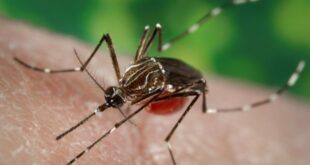Pond was the first place in North America where marbled crayfish were found in the wild.

An invasive species of crayfish that reproduces by cloning itself was discovered last summer in a Burlington, Ont., park — the first time the marbled crayfish has been identified in the wild in North America.
Since then, a group of experts has been working to stop the species from spreading.
The crayfish are in City View park, on Burlington’s southwest border with Hamilton.
Brook Schryer, a member of the working group responding to the detection, told CBC Hamilton that it seems the population was contained after the pond was drained.
“We are confident that this is the only location with marbleds presently,” he said in an interview this week.
The detection is concerning, he said. Crayfish can out-compete native species, alter the food chain, spread diseases and affect biodiversity. If populations grow, Schryer said, there could be negative impacts that experts have yet to anticipate.

The group will continue monitoring the surrounding area out of concern they could still spread.
“Initially invasive species get somewhere by humans … but once established, it’s just inevitable that a species is going to spread naturally,” Schryer said.
Schryer is the assistant co-ordinator with the Ontario Federation of Anglers and Hunters’ Invading Species Awareness Program. His organization works with the province and other partners to track invasive species and educate people about them.
In this case, the partners include the City of Burlington, Conservation Halton, the Ontario Ministry of Natural Resources and Forestry (MNRF), and Fisheries and Oceans Canada.
1 crayfish can establish a whole population
According to Ontario’s Invasive Species Centre, the crayfish, also called marmorkrebs, is thought to have originated in the German pet trade in the 1990s before arriving in North America in the early 2000s.
All known crayfish have been female and they reproduce asexually, creating genetically identical offspring. Schryer said that feature has made them popular among people who own predatory aquatic pets that might eat them, since buying one marbled crayfish secures an exponential food source.

Never release an invasive species into the wild, expert says
Brook Schryer of the Ontario Federation of Anglers and Hunters says it’s never the right decision to release an invasive species into the wild.
But that ability to reproduce is also what makes this species so dangerous, Schryer said. Whereas other invasive species often require several individuals to establish a population, one marbled crayfish alone can create hundreds more.
Crayfish first reported in 2021 took 2 years to ID
Although the marbled crayfish population was formally identified in July, the report that led to its finding was created in October 2021, when someone shared a photo of a crayfish at City View Park on citizen science tool iNaturalist in an effort to identify it.
The post flew under the radar until Schryer’s colleague, Premek Hamr, a biologist Schryer calls Dr. Crayfish, flagged it as likely being a marbled crayfish and reported it to the OMNRF.

Hamr spent his early career studying crayfish before switching to teaching and continuing that research part time. Now invasive crayfish have become a problem around the world, and he said his expertise is often called on to identify species, so much so that he’s working on a guidebook.
“People have a hard time telling them apart,” he said.
In May 2022, Schryer, Hamr and their team went to City View Park to conduct a search, set traps and collect samples using Environmental DNA (eDNA) technology in an attempt to find the species.

The crayfish are notoriously difficult to catch, Schryer said, and despite positive eDNA tests, they couldn’t find any specimens on that visit or on a repeat visit in August 2022.
Last winter, city workers drained the ponds in an attempt to freeze and kill any crayfish that had burrowed underground for the winter, but didn’t find any physical evidence then, either. Hamr said the crayfish can survive in temperatures as low as about 4 C, but at freezing temperatures, they go dormant and painlessly freeze to death.
Warming helps crayfish spread
The scientists expect the Burlington population survived last winter, however, because on July 5, 2023, the City View Park groundskeeper, who Schryer and Hamr had met on a visit, alerted the team that he had found a crayfish.

On followup visits through the summer and fall in 2023, working group members captured multiple marbled crayfish, set traps and took samples to look for them in areas around the park.
Warmer winters are one of the reasons this and other species of invasive crayfish are starting to cause problems in Europe and North America, Hamr said, because it becomes easier for the crayfish to live through the season.
“If one survives, then boom — you’re going to have 200 pretty soon,” Hamr said.

In late December, working group members returned to drain the ponds again, collecting over 50 crayfish, Schryer and Hamr said.
Cary Clark, Burlington’s manager of development and stormwater engineering, said that work will continue throughout the winter.

Biologist Premek Hamr says warmer temperatures help the marbled crayfish survive
Since the marbled crayfish can survive temperatures as low as about 4 C, and burrow underground for warmth, it can stay alive during milder Canadian winters, crayfish biologist Premek Hamr said.
Although the park is relatively landlocked, Burlington is within important ecological areas such as the Grindstone Creek watershed, where the marbled crayfish could do some harm.
Fortunately, as things stand, Schryer and Hamr said, the population seems confined to the park. While crayfish can and do travel across land, he said, there are few places they could go without crossing busy roadways.
“I’m hoping the de-watering will have worked,” Hamr said.
But even if it has, wok on the crayfish continues. Schryer said he has heard reports of a recent detection in Nova Scotia.
Ontario recently banned more crayfish
For Schryer, all the work in Burlington shows just how resource intensive the fight to contain these species is.
The working group suspects the Burlington population is the result of someone letting go of crayfish they had had as pets.
Marbled crayfish are regulated as a prohibited invasive species under Ontario’s Invasive Species Act, which means it is illegal to import, possess, deposit, release, transport, breed/grow, buy, sell, lease or trade them.
At the start of this year, the province designated new invasive species, including the genus that includes marbled crayfish, Procambarus, and another crayfish genus, Pacifastacus.
Hamr said this should make it easier to stop those species from spreading.
He and Schryer said it’s crucial that people with marbled crayfish in their possession report them to the MNRF and do not release them or flush them down the drain.
Hamr warns against pouring out water from an aquarium that housed the creatures too, in case it contained small juvenile crayfish.
ABOUT THE AUTHOR

Reporter
Justin Chandler is CBC News reporter in Hamilton. He covers all sorts of stories but has a special interest in how public policy affects people. Justin covered current affairs in Hamilton and Niagara for TVO, and has worked on a variety of CBC teams and programs, including As It Happens, Day 6 and CBC Music. He co-hosted Radio Free Krypton on Met Radio. You can email story ideas to justin.chandler(at)cbc(dot)ca.
*****
Credit belongs to : www.cbc.ca
 Atin Ito First Filipino Community Newspaper in Ontario
Atin Ito First Filipino Community Newspaper in Ontario






